Your donation will support the student journalists of Huntington Beach High School. Your contribution will allow us to cover our annual website hosting costs.
Thank you for supporting our program!
A Guide to Enneagrams
June 10, 2022
Coined by Oscar Ichazo, the enneagram system of personality types works to identify how one’s personality has come about as a result of exposure to past stressors and traumas, instead of identifying fun and quirky characteristics of a person. This typing network does not inform people if they are introverted versus extroverted, but rather what drives them forward in life despite challenges and obstacles — personality is the armor that the individual has built up.
Pictured above is how the enneagram system is visually organized — a circle with many lines drawn inside to display connections between numbers. These numbers, 1 through 9, are what people use to identify themselves, but people are not confined to one type forever; they are prone to move around, either by identifying with something new as life goes on or by gradually navigating through healthy and unhealthy responses to stressors in a way that is similar to another type. Often, the best way to discover what type a person is is by reading through all of them and finding which one makes them the most uncomfortable, requiring high skills of self-reflection and analysis.
The enneagram system of personality types is extensive and extremely detailed — between healthy versus unhealthy types, stress versus growth movements, subtypes, and wings, the system can feel too intimidating to dive into, but it does not take an expert to understand.
Type 1: The Reformer
Commonly also referred to as The Perfectionist, Ones are exclusively led by their morality, defined by society, by peers, or by themselves. They strive to improve themselves exponentially and never make mistakes, but often slip into the trap of becoming too critical or idealistic. Ones resist instinctual urges and work toward harmony of the mind, body, and spirit. This pursuit of perfection stems from a childhood full of being told that they must never stoop to the level of their peers and that they are “one of the good ones” or “a pleasure to have in class.” They are disconnected from an authority figure that should have been emotionally present and thus spend their lives extremely self-critical to achieve high standards so as to close that gap and prove their worth.
Josh Keefe, a YouTuber who is currently making an extensive video essay series on the enneagram system, says “Ones feel like there is something inherently wrong with either themselves or with the world around them, which creates a deep need for them to correct the imperfections and injustices they face throughout their lives. This could range from little mistakes made by others… to entire oppressive systems deeply rooted in prejudice and ignorance… But it’s important to remember that no matter how critical they are of others, they’re even harder on themselves.”
Healthy Ones strive to be objective, humane, and ethical in their decision-making and do not let themselves fall victim to their fatal flaw of self-righteous anger as they do make an effort to apologize for their mistakes. Examples from popular media and culture include Mary Poppins (Mary Poppins), Katara (Avatar: The Last Airbender), Bruce Wayne “Batman” (The Batman), Ming Lee (Turning Red), Hermione Granger (Harry Potter series), Elsa (Frozen), T’challa (MCU), and EVE (WALL-E).
Unhealthy Ones are antagonistic toward the failures of those around them and believe that they must force the world to comply with their idealistic standards if they want to see preferable results. Examples from popular media and culture include Nina Sayers (Black Swan), Thanos (MCU), Judge Claude Frodo (The Hunchback of Notre Dame), Angela Martin (The Office), Charlie Barber (Marriage Story), and Anton Ego (Ratatouille).
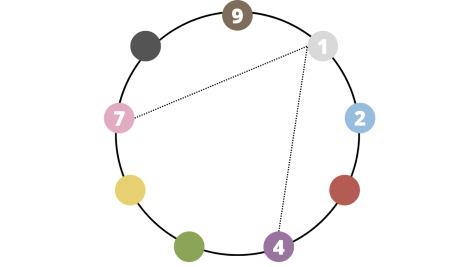
There are two wing varieties per type and for Ones, there are 1w9 and 1w2, pronounced “one wing nine” and “one wing two.” 1w9s, also referred to as The Optimist, share the secondary type of Nine, which culminates in a constant internal battle within themselves where their mission of perfection and their mission of maintaining peace come into conflict; self-imposed rules are randomly stuck to then ignored, causing some people to call 1w9s hypocritical or fickle. 1w2s, also referred to as The Activist, share the secondary type of Two, which culminates in focusing on guiding others to be upstanding, humane citizens who advocate for social change and justice.
In times of stress, Ones move towards Four as they lament their internal need to be responsible and strict towards themselves when others do not and can engage in frivolous activities without the fear of their internal voice chastising them. In times of growth, Ones move towards Seven as they embrace the spontaneity and passion for an instinctually-driven life that they have repressed within themselves for so long.
Subtypes of One are very similar to each other as they all originate from a need for perfection:
Self-preservation Ones work to improve themselves and their ability to engage in their passions, like controlling her ice magic for Elsa or becoming both the White and Black Swan for Nina Sayers.
Social Ones focus on adhering to societal standards on how a person should behave, setting a perfect standard to look up to, like the practically-perfect-in-every-way Mary Poppins or the hellbent Judge Claude Frollo.
One-to-one Ones focus on perfecting other people and their world at large, like EVE as she protects the last plant for Earth or Thanos as he forcibly balances out the universe’s population.
Putting all of these ideas together, observe Anton Ego’s character development in Disney’s Ratatouille. Anton Ego is a social 1w9 who starts off the film in an unhealthy place and believes his word on culinary arts to be final because of his expertise and status in society. After eating Remy’s dish and re-evaluating his biases, Ego grows towards Seven and invests in Remy’s new restaurant with a much more laid-back attitude and far less self-imposed rules.
If you are interested in learning more about Ones, listen to Sleeping At Last’s song “One” and his podcast episode on how he developed it alongside other Ones.
Type 2: The Helper
Twos find that the most meaningful way to live is to be helpful and kind towards others. Their lives revolve around the notion to be genuinely good and compassionate, but often go too far and end up stuck in a cycle of self-sacrifice and inability to tell people no. They need constant reassurance that their actions are being received well and that they are needed by others — this stems from their childhood experiences of needing to grow up too quickly and take care of their siblings, friends, and parents. They grew up acting as another authority figure for others to make up for the areas in which their intended authority figure did not fulfill. In extreme cases, could lead to Twos focusing more on appearing helpful than genuinely being helpful.
Josh Keefe, a YouTuber who is currently making an extensive video essay series on the enneagram system, says “they have a great fear of rejection and believe that to be rejected by someone means that they are somehow unloveable as they are and cannot meet their own needs — otherwise, it would be selfish. Thus, they feel that they must put on a pleasant face and be helpful and charming to others as a way of seducing them into liking them… giving them the assurance that they are, in fact, loveable.”
Healthy Twos feel that it is a privilege to be in the lives of others and learn that, while helping others is important and brings them happiness, self-care is a vital part of making the world a better place. Examples from popular media and culture include Kiki (Kiki’s Delivery Service), Andrea Sachs (The Devil Wears Prada), Tadashi Hamada (Big Hero 6), Isabella Garcia-Shapiro (Phineas and Ferb), Giselle (Enchanted), and Kronk (The Emperor’s New Groove).
Unhealthy Twos range from intrusive people pleasers to socially-dominating manipulators, but consciously or unconsciously always source from a need to be repaid in some way for their overbearing “kindness.” Examples from popular media and culture include the Beldam “Other Mother” (Coraline), Lots-O’-Huggin’ Bear “Lotso” (Toy Story 3), Love Quinn (You), Annie Wilkes (Misery), Mother Gothel (Tangled), and Cher Horowitz (Clueless).
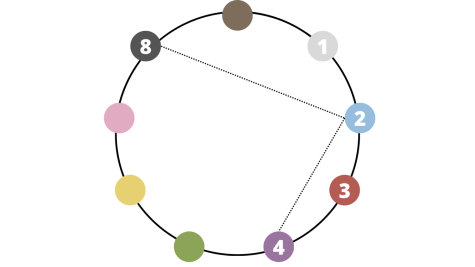
(Infographic by: Ella Acciacca)
There are two wing varieties per type and for Twos, there are 2w1 and 2w3, pronounced “two wing one” and “two wings three.” 2w1s, also referred to as The Companion, share the secondary type of One, which culminates in the belief that their kindness can help heal the world at large and make their community a better place. 2w3s also referred to as The Host, share the secondary type of Three, which culminates in the belief that remaining sociable, compassionate, and adaptable throughout life is the best way to help others.
In times of stress, Twos move towards Eight as they protect themselves from being controlled and taken advantage of by aggressively returning the favor full-throttle towards others under the guise of helping them become better. In times of growth, Twos move towards Four as they let go of their obligation to others by focusing inwards and becoming more self-nurturing.
When it comes to subtypes, Twos differ in what personas they put on to “seduce” the people they try to help:
Self-preservation Twos seduce through a sweet and innocent persona, like the fairytale princess Giselle teleported to the real world or the Sunny Side daycare toy leader Lotso.
Social Twos seduce through their captivating ambition and influence in society, like the reliable brainiac, Tadashi Hamada, or the popular fashionista, Cher Horowitz.
One-to-one Twos seduce through charm, relatability, and romance, like Fireside Girl troupe leader Isabella Garcia-Shapiro or the manipulatively perfect Other Mother.
Putting all of these ideas together, observe Kronk’s character development in Disney’s The Emperor’s New Groove. Kronk is a self-preservation 2w3 who defies any stereotypes of all Twos trying to endlessly manipulate people because he is genuinely just a dumb, happy, and helpful guy. He is thrust into situations that test his character strength but always opts to be accommodating to others and to step in when needed. Kronk never moves to an aggressive, dominating Eight in the course of the movie, but he does move to Four as he recognizes that Yzma does not appreciate him (or his spinach puffs) and he shifts to the side of the good guys before living out his days teaching children how to speak squirrel.
If you are interested in learning more about Twos, listen to Sleeping At Last’s song “Two” and his podcast episode on how he developed it alongside other Twos.
Type 3: The Achiever
Type Threes are self-assured, charming, and highly ambitious in their journeys towards success and proving themselves to have worth. Threes recognize that when they were younger they were praised for their talents and achievements so, as they advance through life, the approval and applause from others drives them forward — their authority figure was present in childhood but imposed an attitude of earning positive recognition. This may result in Threes being overly conscious of their social image and being overly obsessive with ruining others’ achievements so as to not dim down their own.
Josh Keefe, a YouTuber who is currently making an extensive video essay series on the enneagram system, says “overidentifying themselves with what they do and creating an image of success in the eyes of others causes Threes to lose touch with their feelings, who they really are, and what actually matters to them, leaving them feeling empty.”
Healthy Threes are ambitious to improve themselves and be role models for those around them, garnering respect through modest confidence, authenticity, and competent efficacy with their passions. Examples from popular media and culture include Elle Woods (Legally Blonde), Amity Blight (The Owl House), Tiana (The Princess and the Frog), Hercules (Hercules), Buzz Lightyear (Toy Story series), and Kim Possible (Kim Possible).
Unhealthy Threes often fall into the trap of bringing down others to lift themselves up, giving in to their primal flaws of vanity and self-deceit, and/or trying too hard to gain approval from their peers. Examples from popular media and culture include Mr. Fox (Fantastic Mr. Fox), Robert Parr “Mr. Incredible” (The Incredibles), Isabela Madrigal (Encanto), Batman (LEGO Batman), Pacifica Northwest (Gravity Falls), BoJack Horseman (BoJack Horseman), Jennifer Check (Jennifer’s Body), and Rachel Berry (Glee).
An important thing to mention about Three characters in media is that while they seem overwhelmingly unhealthy on this list, their stories often feature them as main characters who must overcome their unhealthy behavior. More than half of the unhealthy characters mentioned going through a process of becoming healthy as they continue on through their stories.
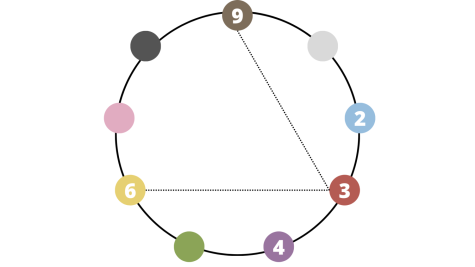
There are two wing varieties per type and for Threes, there are 3w2 and 3w4, pronounced “three wing two” and “three wing four.” 3w2s, also referred to as The Enchanter, share the secondary type of Two, which culminates in an attitude that revolves around bringing up select peers that they deem worthy with them in success — either to admire the Three for gifting them the pathway to their accomplishments or to take the blame for any failures that may come. 3w4s, also referred to as The Expert, share the secondary type of Four, which culminates in isolating themselves from the support of others and working through their hardships by themselves so as to solely take credit for their fame and be viewed as flawless celebrities who suffered through hardships others could never even dream of.
In times of stress, Threes move towards Nine as they become unattached and apathetic towards their goals and lose motivation to reach their full potential. In times of growth, Threes move towards Six as they allow others to aid them in achieving their objectives and give up their vanity without losing their ambition.
Three subtypes vary off on the reasons and ways that they personally achieve their goals and become successful:
Self-preservation Threes define success as maintaining material security and engaging, while improving, in their passions, like the hardworking and persistent Tiana with a dream of opening her father’s restaurant or the uncomfortably passionate Rachel Berry who demands every solo in every Glee club performance.
Social Threes define success as the state of being continually admired and the pursuit of flawlessness, like the heroic demigod Hercules or the perfect golden child Isabela Madrigal.
One-to-one Threes define success as attracting others on the basis of pleasure and likeability, like the valley-girl lawyer Elle Woods or the burnt-out-celebrity-status BoJack Horseman.
Putting all of these ideas together, observe Mr. Fox’s character development in Wes Anderson’s Fantastic Mr. Fox. Mr. Fox is a social 3w4 who rejects his wild, animalistic tendencies despite excelling in his natural skills. He strives to be a personable figure in his community, from his whack-bat trophy history to his multiple inspiring toasts. Only when he accepts his nature, confronts his fear of wolves, and accepts how he must live underground to survive does he fully transition to Six and become healthy.
Fantastic Mr. Fox describes the attitude of Threes perfectly: “I think I have this thing where I need everybody to think I’m the greatest, the quote-unquote “Fantastic Mr. Fox,” and if they aren’t completely knocked out and dazzled and kind of intimidated by me, then I do not feel good about myself.”
If you are interested in learning more about Threes, listen to Sleeping At Last’s song “Three” and his podcast episode on how he developed it alongside other Threes.
Type 4: The Individualist
Fours are commonly seen as the most introspective type in the enneagram, as they are highly self-aware, creative, honest, romantic, and easy to intimacy with others. Since childhood, they have created a “fantasy self” where they picture themselves as more idealized, fanciful people based on their interests and morals but when they cannot achieve that version of themselves, they retract into their emotions and wallow in self-pity. Fours felt disconnected from authority figures throughout their childhood and relentlessly tried to find out why, assuming it was always a mistake on their part for being too unusual. They fear being too different from everyone else and thus, never finding a place where they truly belong, resulting in a dormant state of sadness and melancholy.
Josh Keefe, a YouTuber who is currently making an extensive video essay series on the enneagram system, says “[Fours] feel as though something is missing in their lives, something that they see as somehow unavailable but ideal, which can lead to them overidentifying with their negative feelings and dwell in melancholy.”
Healthy Fours are honest with themselves in pursuit of understanding their purpose and place in the universe. They are incredibly, emotionally in tune with themselves and others and openly share embarrassing details about themselves with their peers, disregarding their fear of judgment. Examples from popular media and culture include Jane Lane (Daria), Remy (Ratatouille), Tina Belcher (Bob’s Burgers), Dr. Heinz Doofenshmirtz (Phineas and Ferb), and Kaidou Shun (Saiki Kusou no Phi-nan and The Disastrous Life of Saiki K).
Unhealthy Fours metaphorically curl into themselves and cut themselves off emotionally from the rest of the world, overcome with hopelessness and delusional otherness. Examples from popular media and culture include Jinx (Arcane), Christine “Lady Bird” McPherson (Lady Bird), Jason Dean “J.D.” (Heathers), Hamlet (Hamlet), and Joy Wang (Everything Everywhere All At Once).
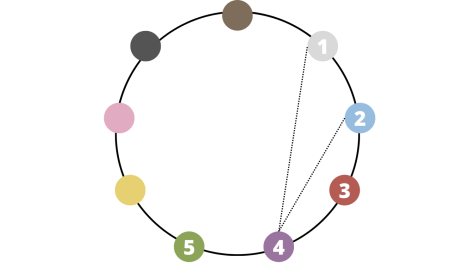
There are two wing varieties per type and for Fours, there are 4w3 and 4w5, pronounced “four wing three” and “four wing five.” 4w3s, also referred to as The Enthusiast, share the secondary type of Three, which culminates in wanting to form genuine connections with others so as to take them along on their journey of discovering their place in the grand scheme of life. 4w5s, also referred to as The Free Spirit, share the secondary type of Five, which culminates in wanting to fully understand why things happen the way they do in the grand scheme of life, ditching their social image for spiritual connection with truth.
In times of stress, Fours move towards Two as they do a full 180 from their isolated tendencies into clingy integration where they overcommit themselves to others rather than continuing to internally reflect on themselves and their actions. In times of growth, Fours move towards One as they distance themselves from fantasy and focus on the present moment grounded in reality﹘adopting the internal harmony that Ones are known for.
The subtypes of Four relate back to how Fours exist within their emotions, specifically with their sadness:
Self-preservation Fours are stoic and strong in their sadness, choosing to withhold information on their emotions to their peers. They often project bubbly personas while experiencing droughts, like the intensely awkward but loveable Tina Belcher or the overly self-aware Joy Wang.
Social Fours are outward and outspoken in their sadness, comparing their emotions to others in the same situation and gauging how well they are doing through that process, like the ever-monologuing Dr. Heinz Doofenshmirtz or the equally ever-soliloquizing Hamlet.
One-to-one Fours are assertive and almost competitive in their sadness, seeking companionship and aid when experiencing depression in their moods, like the aspiring chef Remy or the emotionally and literally explosive J.D.
Putting all of these ideas together, observe Christine “Lady Bird” McPherson’s character development in Greta Gerwig’s Lady Bird. Christine is a one-to-one 4w3 who is in constant conflict with her mother, even to the point of denying the name she gave her at birth, opting instead for “Lady Bird.” Throughout the movie, Lady Bird explores her relationships with boys, her best friend, and her family while trying to become her own person and abandon Sacramento for better things on the east coast. She finds herself over-attaching to her peers at different points in her senior year, stuck in the fantasy utopia she created about college. In the end, Christine accepts her god-given name and calls her mother to tell her how wonderful Sacramento was underneath the terrible facade she imposed on other people — Christine ends the movie not entirely healthy, but in the direction of growth as she grounds herself in reality.
If you are interested in learning more about Fours, listen to Sleeping At Last’s song “Four” and his podcast episode on how he developed it alongside other Fours.
Type 5: The Investigator
Type Fives relentlessly partake in the pursuit of knowledge and seek out stability through understanding their surroundings. Fives are concerned with nuance when discussing issues in the world but tend to negatively react to being told they are wrong. They possess a general fear of incompetence and often fall into critical and cynical behaviors. This stems from their childhood experiences of separating themselves from authority figures and forcing themselves to figure out the world independently, believing they must earn their right to survival.
Josh Keefe, a YouTuber who is currently making an extensive video essay series on the enneagram system, says “Fives greatly value autonomy and self-sufficiency. [They] fear being incompetent and having emotional demands placed on them, causing them to detach from their feelings and overidentify [with] what they’re thinking.”
Healthy Fives embrace the possibility of failure as they recognize it is necessary to reach truth and knowledge. Examples from popular media and culture include Milo Thatch (Atlantis: The Lost Empire), Matilda Wormwood (Matilda), Daria Morgendorffer (Daria), Raven (Teen Titans), Velma Dinkley (Scooby-Doo), Hiro Hamada (Big Hero 6), and Peter Parker “Spider-Man” (The Amazing Spider-Man).
Unhealthy Fives refuse to acknowledge any biases or inconsistencies in their logic and reject social attachments as they descend into madness. Examples from popular media and culture include Sherlock Holmes (Sherlock), Beth Harmon (The Queen’s Gambit), GLaDOS (Portal), Lewis “Cornellius” Robinson (The Robinsons), and Evelyn Deavor “Screenslaver” (The Incredibles 2).
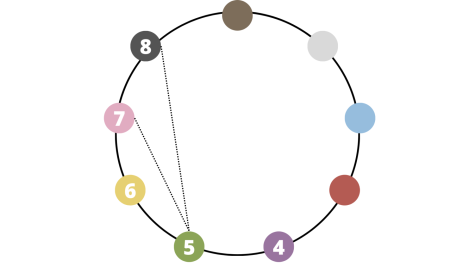
There are two wing varieties per type and for Fives, there are 5w4 and 5w6, pronounced “five wing four” and “five wing six.” 5w4s, also referred to as The Philosopher, share the secondary type of Four, which culminates in preferring discovery to occur when alone and in a setting where recharging is readily available. 5w6s, also referred to as The Troubleshooter, share the secondary type of Six, which culminates in preferring discovery to occur as a collaborative effort with like-minded individuals that share the same level of passion and interest.
In times of stress, Fives move towards Seven as they lose their characteristic concentration and become extremely scatter-brained, abandoning their core pursuit of knowledge. In times of growth, Fives move towards Eight as they adopt a decisive and definitive approach to discovering and enforcing the truth of the universe.
Subtypes of Five derive from the need to understand something specific around them to the best of their abilities:
Self-preservation Fives seek to understand every nuance of themselves in a mission to operate in the best circumstances for themselves, like telekinetic wonder kid, Matilda Wormwood or the chess expert, Beth Harmon.
Social Fives seek to understand the world around them and how each part links to the next, like the inquisitive Atlantis-expert, Milo Thatch or the detail-oriented detective, Sherlock Holmes.
One-to-one Fives seek to understand individuals they find enticing and often mysterious, like the monotonous teenager, Daria Morgendorffer or the torturous supercomputer, GLaDOS.
Putting all of these ideas together, observe Hiro Hamada’s character development in Disney’s Big Hero 6. Hiro is a self-preservation 5w4 who is trying to emotionally handle his brother’s death while uncovering the dark secrets behind a masked villain using his technology for evil. Though he does work well in a team, he can only fully collect his thoughts and plan accordingly when he is alone — though his friends are like-minded and intelligent, they act more as emotional support (which he desperately needs as he has grown too emotionally distant from himself to ever fully be successful on his mission of self-preservation) rather than big-decision planners. Hiro grows scatterbrained when distracted by revenge and anger, but, through the aid of his companions, he transitions to Eight and learns how to command a team effectively.
If you are interested in learning more about Fives, listen to Sleeping At Last’s song “Five” and his podcast episode on how he developed it alongside other Fives.
Type 6: The Loyalist
Sixes are team players, often relying on the support of others to escape their anxiety about uncertainties in the world. They are extremely loyal to systems, beliefs, or people (hence their title) and find themselves battling between their inability to make big decisions and their resistance to others deciding for them, connecting back to a basic fear of being controlled. The childhoods of Sixes often showcase a divide between independence and complete dependence, culminating in a scatterbrained and guarded attitude into adulthood. Sixes felt a strong connection to their authority figure but trusted them blindly, leaving themselves open to potential manipulation.
Josh Keefe, a YouTuber who is currently making an extensive video essay series on the enneagram system, says “Sixes are alert and watchful and focus on detecting threats in their environment. However, their strong sense of fear can make it hard for them to trust their own thoughts, causing them to sometimes come across as anxious and paranoid.”
Healthy Sixes fully embody their independent nature and their need for cooperation, accepting their anxiety and working off of it rather than abandoning it. Examples from popular media and culture include Lexi Howard (Euphoria), Natasha Romanoff “Black Widow” (MCU), Dipper Pines (Gravity Falls), Gabriella Montez (High School Musical series), Zuko (Avatar: The Last Airbender), and Anya/Grand Duchess Anastasia (Anastasia).
Unhealthy Sixes envelop themselves within their fears and often lash out at potential companions to protect everyone involved, jumping from emotion to emotion and giving mixed signals. Examples from popular media and culture include Marvin (Finding Nemo), Shinji Ikari (Neon Genesis Evangelion), Catra (She-Ra and the Princesses of Power), Chloe Price (Life is Strange), Woody (Toy Story series), Chara (Undertale), Cameron Frye (Ferris Bueller’s Day Off), and Edward Cullen (Twilight saga).
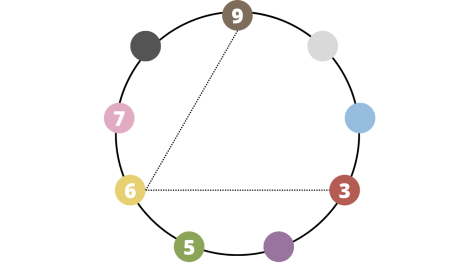
There are two wing varieties per type and for Sixes, there are 6w5 and 6w7, pronounced “six-wing five” and “six-wing seven.” 6w5s, also referred to as The Guardian, share the secondary type of Five, which culminates in prioritizing their safety and stability, placing their value on their ability to protect others with their knowledge about the world. 6w7s, also referred to as The Confidant, share the secondary type of Seven, which culminates in prioritizing their support system and seeking assurance and affirmation through others.
In times of stress, Sixes move towards Three as they adopt an overly competitive and judgemental attitude that contrasts their usual patience and collaborative behavior. In times of growth, Sixes move towards Nine as they relax about their anxieties and lean more into their optimistic mannerisms.
Each subtype of Six links to how they interact with their fears:
Self-preservation Sixes escape their fears by putting on a strong and confident persona to tackle them, like the feisty Grand Duchess Anastasia or the abandoned Catra.
Social Sixes escape their fears by relying heavily on authority figures or ideologies, like the persistent Zuko or the genocidal Chara.
One-to-one Sixes escape their fear by making close connections with other people with a “us against the world” shared mentality, like the super-spy Natasha Romanoff with the Avengers or the stick-in-the-mud Sheriff Woody with Andy’s toys.
Putting all of these ideas together, observe Cameron Frye’s character development in Ferris Bueller’s Day Off. Cameron is a one-to-one 6w5 who fears going against authority, specifically his father when Ferris tells him they need to drive his dad’s cool car. He is a very anxious Six who often has to move into an aggressive Three when arguing with Ferris and goes catatonic when he moves to Nine — his shifts in behavior are extreme because he hides his emotions very regularly as many Sixes do. By the end of the movie, Cameron has moved to Nine, but it is too soon to see if this shift is too sudden or if he will genuinely become a less anxious person because the audience never gets to see him confront his father. However, much of his fear actually is rooted in the concept of disobedience rather than an actual person.
If you are interested in learning more about Sixes, listen to Sleeping At Last’s song “Six” and his podcast episode on how he developed it alongside other Sixes.
Type 7: The Enthusiast
Type Sevens embrace spontaneity and fun, seeking out experiences and people that will bring them pleasure and avoiding those that will not. Sevens do have a strong connection to quick and agile thinking skills, but often find themselves distracted and undisciplined when they misapply their talents. They fear pain and displeasure, stemming from childhood experiences brimming with a perceived lack of love and nurturing from authority figures in the way that they needed.
Josh Keefe, a YouTuber who is currently making an extensive video essay series on the enneagram system, says“While their fear of being trapped can fuel positive, quick thinking, it can also cause them to act out in self-indulgent and excessive ways in their search for pleasure and happiness.”
Healthy Sevens fully trust their instincts and easily find all the inherent goodness in the world, finding focus in their specialized areas of interest. Examples from popular media and culture include Rapunzel (Tangled), Karen Smith (Mean Girls), Finn Mertens (Adventure Time), Mabel Pines (Gravity Falls), Donkey (Shrek), Miriam Mendelsohn (Turning Red), and Greg (Over the Garden Wall).
Unhealthy Sevens fall into the trap of being self-obsessed, materialistic, and greedy, acting on all impulses without necessary critical thinking skills. Examples from popular media and culture include Micheal Scott (The Office), Captain Jack Sparrow (Pirates of the Caribbean), Fleabag (Fleabag), Coraline Jones (Coraline), Rodrick Heffley (Diary of a Wimpy Kid series), Alex Russo (Wizards of Waverly Place), and Prince Naveen of Maldonia (The Princess and the Frog).
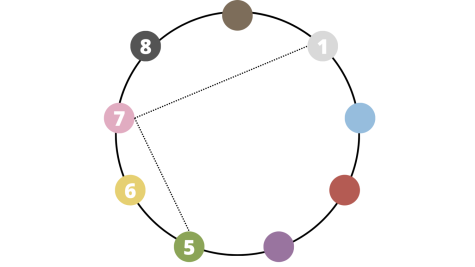
There are two wing varieties per type and for Sevens, there are 7w6 and 7w8, pronounced “seven wing six” and “seven wing eight.” 7w6s, also referred to as The Pathfinder, share the secondary type of Six, which culminates in a less restricted attitude about life so long as they prioritize their friends and ideologies. 7w8s, also referred to as The Opportunist, share the secondary type of Eight, which culminates in a more restricted attitude where they focus on tasks that need to be done for their personal happiness.
In times of stress, Sevens move towards One as they become more perfectionistic and restrain their instincts, despite the fact that they rely on them so heavily. In times of growth, Sevens move towards Five as they focus on their interests and find genuine fascination with life as they learn more about it.
Sevens’ subtypes revolve around how they seek out excess pleasure and where their instincts lead them:
Self-preservation Sevens have instincts that lead them to themselves, seeking out experiences and people to feel more whole with the priority on themselves the whole time, like the forever dreaming Rapunzel or the elusive Captain Jack Sparrow.
Social Sevens have instincts that lead them to the world, finding joy and responsibility in leading people towards happiness, like the heroic Finn or the exceptionally extroverted Micheal Scott.
One-to-one Sevens have instincts that lead them to others, connecting with people who share their same passions for life and special activities, like the awkward preteen Miriam Mendelsohn or the mommy-issues-filled Coraline Jones.
Putting all of these ideas together, observe Prince Naveen’s character development in Disney’s The Princess and the Frog. Naveen is a self-preservation 7w6 who starts off the movie only caring about himself and having the financial backing for his extravagant lifestyle. Tiana, a self-preservation 3w2, challenges him with her persistent attitude towards her dreams and helps him focus on what he loves (playing music) in a fulfilling way. Naveen helps Tiana get more in touch with her feelings and helps her calm down a bit while still supporting her dreams, making them a healthy couple that challenges and supports each other despite not being on the same stress-growth triangle.
If you are interested in learning more about Sevens, listen to Sleeping At Last’s song “Seven” and his podcast episode on how he developed it alongside other Sevens.
Type 8: The Challenger
Eights are decisive, resourceful self-advocates who feel the need to have control over their environment and make big decisions for themselves and others. They can be seen as intimidating and temperamental, but their confrontational nature helps them efficiently problem solve and avoid bigger conflicts in the future. Above all other enneagram types, Eights are least affected by how others perceive them as they deny shame or fear of how their actions impact their reputation. In their childhoods, Eights rejected their maternal authority figures and opted to fulfill the strong, paternal role in their lives as they fear being weak and dependent on others.
Josh Keefe, a YouTuber who is currently making an extensive video essay series on the enneagram system, says “their impulsive tendency to take what they want can also lead to them becoming domineering, aggressive, and unwilling to experience vulnerable feelings.”
Healthy Eights are natural leaders who are self-confident, self-righteous, and self-sufficient, standing up for those around them that cannot stand up for themselves. Examples from popular media and culture include Tigress (Kung Fu Panda), Merida (Brave), Jo March (Little Women), Esmerelda (The Hunchback of Notre Dame), Princess Jasmine (Aladdin), and General Li Shang (Mulan).
Unhealthy Eights defy any control that others try to impose upon them, defaulting to a constantly combative, megalomaniac state. Examples from popular media and culture include Nate Jacobs (Euphoria), Veruca Salt (Willy Wonka and the Chocolate Factory), Katerina “Kat” Stratford (10 Things I Hate About You), Anakin Skywalker (Star Wars saga), Terence Fletcher (Whiplash), and Regina George (Mean Girls).
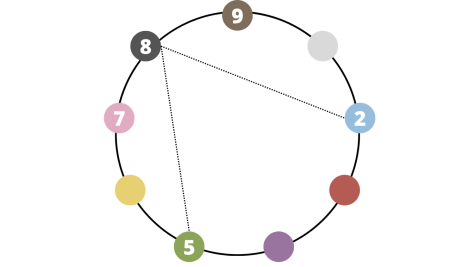
There are two wing varieties per type and for Eights, there are 8w7 and 8w9, pronounced “eight wing seven” and “eight wing nine.” 8w7s, also referred to as The Nonconformists, share the secondary type of Seven, which culminates in welcoming conflict because they know they can successfully stand up for themselves and being very assertive in how their instincts lead them. 8w9s, also referred to as The Diplomat, share the secondary type of Nine, which culminates in not welcoming much conflict because they do not find it to be as useful or productive, as calmly taking action to ensure further conflict does not persist and is very patient and protective in nature.
In times of stress, Eights move towards Five as they become hyper-critical of how they avoid mistakes and continue protecting themselves, appearing detached and unfocused. In times of growth, Eights move towards Two as they focus their leadership on helping others and being more selfless.
The subtypes of Eight are determined by how they utilize their directness:
Self-preservation Eights focus on creating a contained security blanket for themselves and do not have an easy time being exceptionally vulnerable, like the passionate feminist Jo March or the obnoxious feminist Kat Stratford.
Social Eights focus on protecting those who cannot protect themselves and project their vulnerabilities onto their mentees to fix for them, like the martial arts master Tigress or the demanding Terence Fletcher.
One-to-one Eights focus on dominating and possessing a social space’s energy by being the center of attention and their vulnerability guides them on how they stand up to other people, like the outspoken Princess Jasmine or the mean girl Regina George.
Putting all of these ideas together, observe Esmerelda’s character development in Disney’s The Hunchback of Notre Dame. Esmerelda is a social 8w7 who actively fights for her people and those that she relates to as an outcast. She remains in growth movements towards Two fairly consistently throughout the film but retracts into herself when confronting her outcast nature and vulnerabilities in the world. She has adapted to taking care of herself in any way possible but does not view herself as desperate or needy, rather going through life with self-defined power.
If you are interested in learning more about Eights, listen to Sleeping At Last’s song “Eight” and his podcast episode on how he developed it alongside other Eights.
Type 9: The Peacemaker
Nines are creative, stable, supportive, and coincidentally very peaceful in nature. Their response to conflict is often to take it slowly and view it from an objective stance informed by emotional reactors, not the other way around. However, this approach often is seen as lazy, limited, and an excuse to not involve themselves in bettering their lives. Nines had close connections with their authority figures but defaulted to tuning out negative factors or input in those relationships, wishing them away to focus on what was going right rather than what was going wrong.
Josh Keefe, a YouTuber who is currently making an extensive video essay series on the enneagram system, says “[Nines’ attitude toward avoiding conflict could] be because they lack a clear sense of themselves and deeply fear conflict, meaning they repress their own desires and replace them with the agendas of others just to keep the peace, causing them to grow increasingly frustrated for not going after what they really want.”
Healthy Nines find balance in being deeply receptive and supportive of others, connecting with the spiritual world at large to understand a greater purpose they are destined for, and are connected to their personal wants and desires. Examples from popular media and culture include Harry Potter (Harry Potter series), Wendy Corduroy (Gravity Falls), Jake the Dog (Adventure Time), Garnet (Steven Universe), Haruhi Fujioka (Ouran High School Host Club), WALL-E (WALL-E), and Link (The Legend of Zelda).
Unhealthy Nines struggle to find any balance between their relationships and themselves, hardly self-advocating and pretending that problems do not exist. Examples from popular media and culture include Rue Bennett (Euphoria), Peter B. Parker “Spider-Man” (Spider-Man: Into the Spider-Verse), Basil (OMORI), Red Guy (Don’t Hug Me I’m Scared), Pam Beesly (The Office), and Cady Heron (Mean Girls).
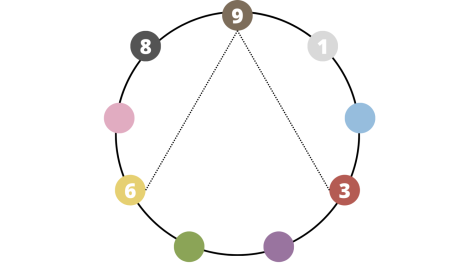
There are two wing varieties per type and for Nines, there are 9w8 and 9w1, pronounced “nine wing eight” and “nine wing one.” 9w8s, also referred to as The Advisor, share the secondary type of Eight, which culminates in being far more adventurous, assertive, and routine-oriented than other Nines. 9w1s, also referred to as The Negotiator, share the secondary type of One, which culminates in being far more idealistic, creative, and focused than other Nines.
In times of stress, Nines move towards Six as they lose their connections to others due to their increasing anxieties and have trouble trusting their own minds. In times of growth, Nines move towards Three as they leave their state of sloth and disconnection to focus their energy on what they care about.
Seeing as Nines fall to the primal sin of sloth, subtypes are determined by what they choose to aptly participate in and what they use to define themselves as:
Self-preservation Nines participate in the act of taking care of themselves and setting up a routine so as to make the world feel more real and grounded, like the adorably systematic WALL-E or the intensely guilt-filled Basil.
Social Nines participate in the act of involving themselves in the wants of groups at the expense of their own wants so as to identify with the group itself, like the boy-who-lived Harry Potter or the expendable mean girl Cady Heron.
One-to-one Nines participate in the act of connecting with an individual they want to find themselves in and merge interests with, like the quite literally fused Garnet or the recovering addict Rue Bennett.
Putting all of these ideas together, observe Peter B. Parker’s character development in Sony’s Spider-Man: Into the Spider-Verse. Peter B. is a one-to-one 9w8 who learns through his new Spidey friends that in order to properly get back together with his M.J., he needs to own up to his mistakes, confront his fears, and properly balance his life as Peter B. and Spider-Man. Peter B. finds different areas of focus when moving to Three but his flaws are usually grounded in being disconnected rather than overly anxious.
If you are interested in learning more about Nines, listen to Sleeping At Last’s song “Nine” and his podcast episode on how he developed it alongside other Nines.

